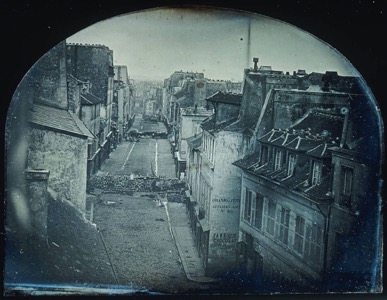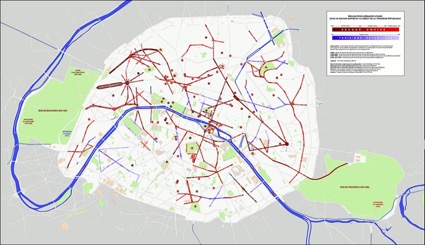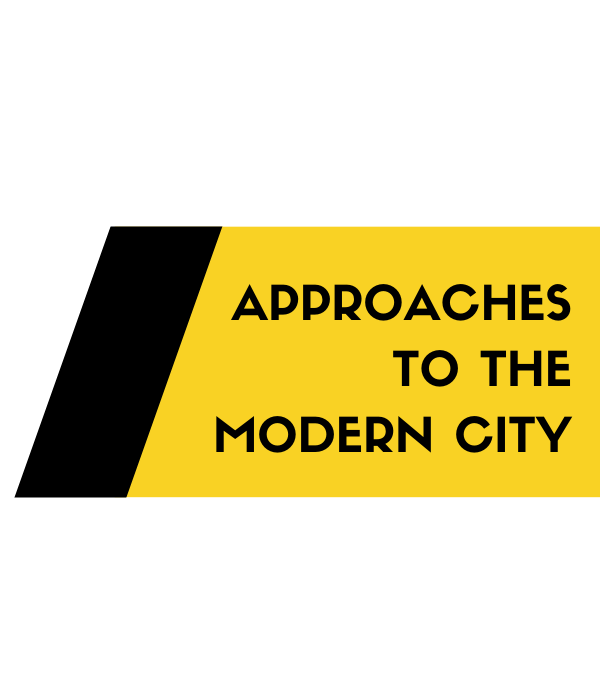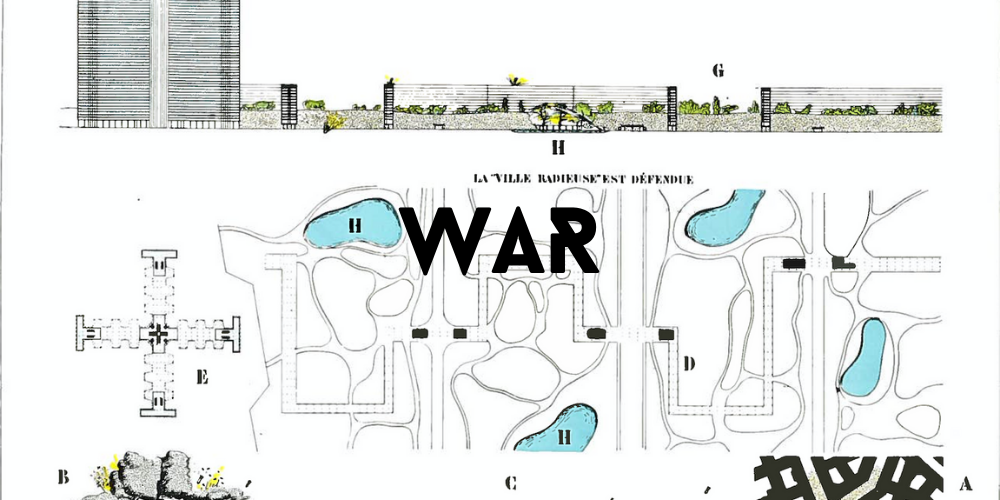Questions
How has war affected the history of Paris? Are its marks visible?
Discussion
The wide boulevards and avenues of Paris are the subject of a familiar joke that generally goes as follows, “the streets of Paris were built so wide so that conquering armies could march down them ten soldiers abreast.” This unattributed quote is clearly meant to make fun of France’s military history and imply that its capital city was built to comfortably accommodate foreign armies that France had surrendered to. The joke conjures up images of the Third Reich’s conquest of France, or perhaps the liberation of Paris by the United States several years later.
But this joke explaining Paris’ wide, tree-lined boulevards and grand avenues is not far from the truth. The streets of the French capital were not made wide to accommodate foreign militaries, but the French military. Among the motivations Baron Haussmann had for constructing wide streets was to let in not just sunlight, but soldiers. As Kim Willsher writes, “Haussmann cut a swathe through the cramped and chaotic labyrinth of slum streets in the city centre, knocked down 12,000 buildings.” (Willsher) And Haussmann acknowledges in his memoirs the military motive of, “gutting of old Paris, of the quarter of riots and barricades.” (de Moncan 17).

Figure 1: Barricades built during an uprising in Paris.
Paris was the sight of a number of revolts from the French Revolution onwards, and these uprisings often took a similar form. Protestors would take furniture, detritus, cobblestones from their street, or whatever they could easily uproot, to form barricades on the streets. The narrow streets of medieval Paris made it easy to build barricades to block these small alleys and ways off. Protestors could essentially seal off whole sections of the city from French authorities and military, “a genuinely emergent, unplanned network—played a starring role, with many working-class neighborhoods successfully thwarting invading troops through road blockades.” (Gray) They were able to bolster their position with these fortified barricades and put their opponents in the disadvantageous position of having to charge these barricades against armed rebels.
These tactics played out time and time again throughout the early nineteenth century. In 1830’s July Revolution, protestors rose up against the Bourbon Restoration government and successfully ousted the King, who was replaced on the throne by his cousin, Louis Philippe of Orleans. Just two years later, students rioted in Paris against his rule in what became known as the June Rebellion, though it remains known not because of what it accomplished (which was little) but because it was adapted in Victor Hugo’s Les Miserables. King Louis Phillipe himself was toppled in the Revolution of 1848 and replaced by President and later Emperor Louis Napoleon Bonaparte.
Bonaparte sought to turn Paris into a capitol worthy of the empire he was building abroad and so began the reconstruction of Paris under the newly assigned Prefect of the Seine, Baron Haussmann. De Moncan writes of Bonaparte’s thoughts: “Why, Bonaparte pondered, was it not more like London, with its grand parks and gardens, its tree-lined avenues and modern sewage system?” (Willsher ). Though the ostensible reason for Paris’ new array of wide avenues and boulevards was to bring light to the shaded streets of the city, they had the ulterior purpose of making it much easier for the French military and policing authorities to traverse the city, and much harder for potential rioters to take control of it.

Figure 2: New streets built by Haussmann during the Second Empire indicated in red.
The first true test of this use of urban design to counter urban unrest was the Paris Commune. In 1870, France and Prussia went to war over hegemony of the southern German Catholic states, a war that Prussia won, seizing the French region of Alsace-Lorraine as a prize. The Prussians crowned their king as Emperor of a united Germany in the grand French palace of Versailles of all places, in the Hall of Mirrors. This humiliation of France also led to the fall of Emperor Napoleon III, who was forced out of power. The new French Republic was forced by Prussia to disband its army, though the National Guard was allowed to remain. The National Guard was more of a lightly organized militia than a formal military body like the modern American National Guard. The Guard was made up of armed working-class citizens who held the same beliefs they did before they were given arms (Milza 143). Thus, the National Guard was far more politically conscious than the regular military and revolted alongside the citizens of Paris in early 1871, seizing control of the city. The walls of the city, meant to keep invaders out, ironically kept the French government at bay, though only for a few months (Milza 108).
In what became known as the “Semaine Sanglante”, “the Bloody Week”, France’s wide boulevards and avenues became the downfall of the commune. An insider alerted the French Army that one gate in the walls of Paris, the Port du Jour, was unguarded. The Army quickly seized control and began to pour through the gate and several gates nearby. The wide streets of Paris were easily traversed by the Army. The barricades of uprisings past that once thwarted the French military were easily bypassed as they were no longer constrained by narrow streets and alleys.

Figure 3: The Rue de Rivoli after the French military defeated the Commune.
The walls of Paris had been commissioned to prevent the invasion of Paris by foreign militaries, as had happened in 1814 when coalition forces marched into Paris and ousted Napoleon I. Paris’ medieval walls had been long since demolished after Louis XIV thought Paris was too secure to be invaded. The walls were known as “Walls of Thiers”, named for Prime Minister Adolphe Thiers under whom they were constructed from 1841 to 1844 (during the July Monarchy). Thiers was later the first Prime Minister of the new Third Republic and had to assault the very walls he oversaw the construction of to defeat the Paris Commune. The Walls of Thiers remained until the 1920s when they were torn down, obsolete in the face of modern artillery.

Figure 4: The walls of Thiers.
The walls came down but the division that they created did not leave because the right of way of the walls was filled with the new Boulevard Peripherique, a multi-lane highway that still exists today and traces the outline of Paris proper, separating it from its outlying suburbs with a barrier of asphalt rather than stone. Indeed, all of the entrances into Paris through the Boulevard Peripherique are the same gates that once existed in the Walls of Thiers, continuing the legacy of the fortifications long after they were no longer needed.

Figure 5: The Boulevard Peripherique.
Paris as a city is one that many do not associate with war and conflict (the recent terror attacks excepted), since it escaped the violent 20th century and its world wars largely unscathed. But the very design of Paris was shaped by conflict and violence in both uprisings and invasions. Walls were built to protect the heart of France from its enemies. The streets that run through the city were widened and longtime neighborhoods were demolished to build a new city that would be less likely to revolt against France, and an easily defeated city if it did.
Sources
De Moncan, Patrice. Le Paris D’Haussmann. 2002
Gray, Nolan. “Wide Streets as a Tool of Oppression.” Strong Towns, Strong Towns, 8 Oct. 2018, www.strongtowns.org/journal/2018/10/8/wide-streets-as-a-tool-of-oppression.
Willsher, Kim. “Story of Cities #12: Haussmann Rips up Paris – and Divides France to This Day.” The Guardian, Guardian News and Media, 31 Mar. 2016, www.theguardian.com/cities/2016/mar/31/story-cities-12-paris-baron-haussmann-france-urban-planner-napoleon.
Milza, Pierre. Napoleon III. Perrin, 2007.
Glancey, Jonathan. “Culture – The Man Who Created Paris.” BBC, BBC, 26 Jan. 2016, www.bbc.com/culture/story/20160126-how-a-modern-city-was-born.

